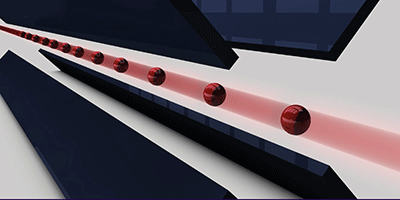A Solid Look-Alike
The physics of complex solids—such as superconductors, multiferroics, and compounds that exhibit colossal magnetoresistance—is often too difficult to tackle with theory or numerical analysis. Building a device that behaves exactly like a solid may instead be a better strategy for modeling these materials. For example, recent research has demonstrated that cold atoms trapped by lasers and arranged in “artificial lattices” can emulate the properties of solids. Now, in Physical Review Letters, theorists propose a combination of ionic and neutral gases that could be the ideal quantum simulator for solids in which electrons interact strongly with lattice vibrations.
Ulf Bissbort at the Institute for Theoretical Physics in Frankfurt, Germany, and his colleagues analyze a system consisting of a one-dimensional chain of laser-trapped ions, interacting with a surrounding cloud of neutral fermionic atoms. Their analysis shows that the two species would play the role of a solid’s atoms and electrons, respectively. What makes the scheme much closer to a real solid than previous cold-atom simulators is the interaction between the electronlike neutral atoms and the ions: the movement of the neutral atoms can induce vibrations of the ions around their equilibrium positions (and vice versa)—an interaction that mimics electron-phonon coupling in a natural solid.
The authors show that the system displays an interesting effect similar to that found in solids, called the Peierls instability: when cooled below a certain temperature, an equispaced chain of atoms with one electron per atom can distort and form dimers and, as a consequence, turn from a metal into an insulator. – Matteo Rini





